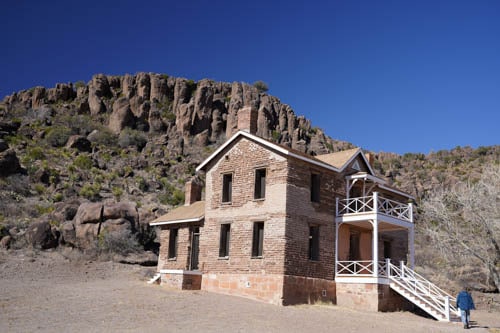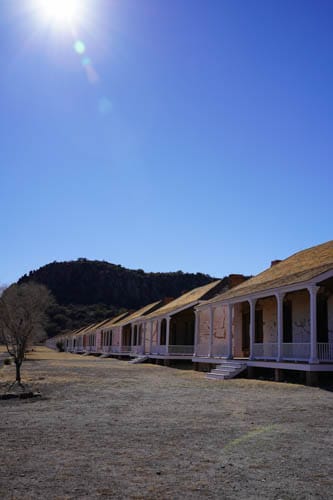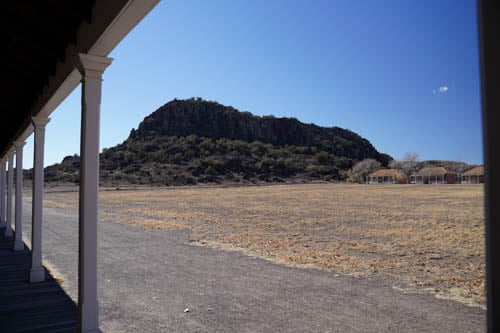Fort Davis is one of the best examples remaining of a military outpost in the American Southwest. It is a reminder of the role the military played in the settlement and development of the West. Fort Davis is one of fourteen forts in the frontier fort system protecting emigrants, mail coaches, and freight wagons on the San Antonio-El Paso Road and the Chihuahua Trail.
Disclosure: Some links on our site are affiliate links. If you purchase a linked item, we will make a commission, at no extra charge to you.

Facts About Fort Davis
- Fort Davis gets its name from Secretary of War Jefferson Davis.
- It’s located in a box canyon. Surrounded on three sides by sheer rock walls. This was to help protect the fort from the cold winter storms.
- The all-black 24th and 25th Infantry Regiments served here. Additionally, the 9th and 10th Cavalry Regiments served here. They were instrumental in defending westward-moving settlers and freight.
- The fort was in existence from 1854 to 1891, although abandoned from 1861 to 1867 due to the Civil War.
- The last major military campaign involving Fort Davis’ troops occurred in 1880.
Life in west Texas during the late 19th century was rough. The Indian Wars were still raging. Depending on when you were there, the country was leading up to the Civil War, or was struggling to heal the wounds from it. Your duties alternated between grueling and boring. One of the few diversions was watching the Army’s experimental Camel Corps, led by Lt. Edward F. Beale, as they lumbered through camp on their way to California.

There are many noteworthy stories from Fort Davis. From the people and units that served there to their impact on history. One of the post’s commanders, Colonel Benjamin Grierson, served with distinction for the Union during the Civil War.
Before the start of the war, Grierson was a music teacher and band leader. With the outbreak of the war, he enlisted as a Captain and aide-de-camp to Major General Benjamin Prentiss. Rising quickly through the ranks, he soon was a cavalry brigade commander in the Army of the Tennessee. Shortly thereafter, he was promoted again to Brigadier General of Volunteers. In this capacity, he led his brigade deep into enemy territory on a raid that drew Confederate resources from Grants Vicksburg assault. He eventually rose to command the Cavalry Corps of the Army of the Mississippi.
Choosing to stay in the regular Army after the war, he was appointed a Colonel in the cavalry. In 1866, he organized the 10th Cavalry. Composed entirely of African American troops, they came to be known as Buffalo Soldiers. His faith in his troops, and his respect for the Native American culture (among other factors) distanced him from his fellow officers. Regardless, he went on to a distinguished career in the post-war Army. Retiring in 1890, as a Brigadier General, he took up ranching near Fort Davis and died in 1911.
Second Lieutenant Henry Flipper was the first African American graduate of West Point. His military career started in 1873. Writing to James Freeman, the newly-elected Georgia congressman, Flipper requested an appointment to West Point. Over the course of several letters between the two, Flipper proved himself to be “worthy and qualified” and officially entered on July 1, 1873.

In an environment of near total social isolation from his classmates, he earned above average grades and graduated 50th in a class of 76. Notably, before being assigned at Fort Davis, he served at Fort Sill and detailed as the post engineer. He was ordered to survey and supervise the construction of a drainage system to eliminate stagnant ponds causing malaria. His efforts proved successful. In 1977, what became known as “Flipper’s Ditch” was designated as a Black Military Heritage Site.
In November of 1880, he arrived at Fort Davis. He served as Acting Assistant Quartermaster and Acting Commissary of Subsistence. Things seemed to be going well for the only African American officer in the US Army, until some commissary funds he was responsible for, turned up missing. Stalling for time, he tried to conceal the loss, which resulted in a court martial.
Unfortunately, he was found guilty. While the Judge Advocate General (the Army’s chief legal officer) recommended a punishment other than dismissal, President Arthur approved the court’s sentence. Henry Flipper fought the rest of his life to have his rank restored. He died in 1940, at 84.
In 1976, the Army Board for Correction of Military Records reviewed his case. They found that his punishment was unduly harsh and therefore, unjust. In 1999, President Clinton granted a full and unconditional pardon.
Many served at Fort Davis. All served with distinction. Earning the reputation of dedication and bravery, they played a vital role in the peaceful settlement of the American west.

Discovering Lt Edward “Ned” Beale came through the area. I had suspected that he made it through based on other research, but following my family ancestry is always interesting for me.
Angela DiLoreto
I have always been fascinated with military history. Being stationed in west Texas for a substantial part of my career, I have had the opportunity to learn both military and western history. But no matter how much I learn, there’s always more interesting stories interwoven with what I’ve already known. Reading about the personal lives of those that took part in the wars makes it more personal. I feel we need to learn from our history and walking in the footsteps of these men helps.
Vince DiLoreto
Getting to Fort Davis
Coming from either the west or east, you’ll likely be on US 90. This highway will bring you into the west Texas town of Marfa, which is a very fun and interesting town to visit. From there, head north on Texas Highway 17 for approximately 20 miles. The Fort Davis Historic Site is just north of the two west of Fort Davis.
Tips for your Trip to Texas’ Fort Davis
- Wear comfortable shoes for walking the unpaved grounds. It is relatively flat, but there are some tripping hazards.
- Allow yourself at least an hour so you’re not rushed. There are placards and informative signs to read. I would suggest putting yourself in the place of those who’ve come before and the hardships faced.


Comments are closed.